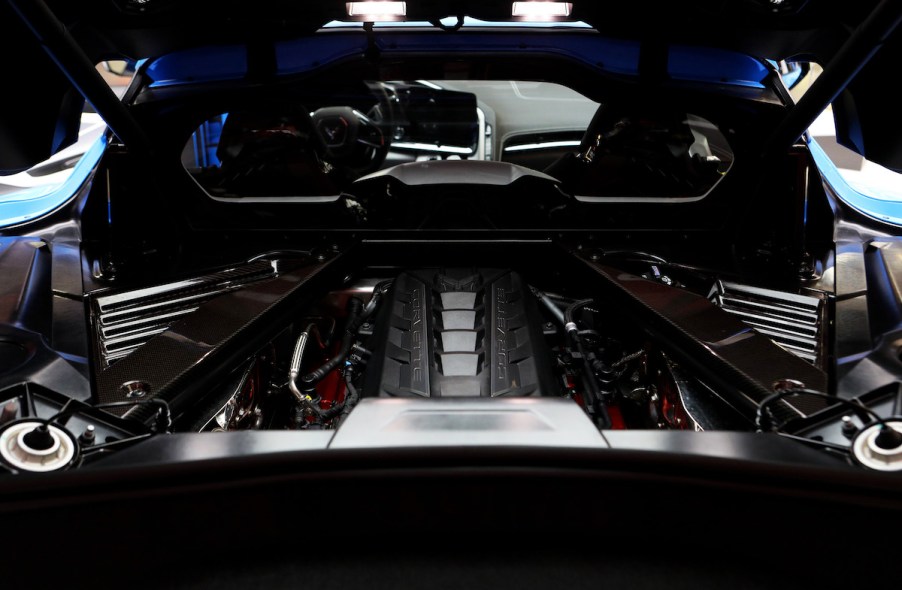
Can Your Car’s Engine Placement Affect How It Handles?
When designing or redesigning a car, automotive engineers must decide where to place the engine and all the other components needed to make the vehicle perform as it should. Most modern mainstream cars use a front-engine design, but some models have a rear-engine placement. American sports cars always used front-engine configurations, but times are changing, as at least one classic car recently adopted a mid-engine layout. So, is it all a marketing ploy, or does engine placement affect a car’s handling?
Front vs. mid vs. rear engine: What’s the difference?

For the sake of discussion, we’ll say a car with its engine in front of the passenger compartment exhibits a front-engine layout. While there are differences in front-engine placement forward or aft of the front axle, we’ll lump them together here.
“Front-mounted engines are the most common engine placement,” How Stuff Works explains. Front-engine placements are popular because they allow the most efficient use of weight and space. That’s also why front-wheel-drive cars dominate the market. Front-engine layouts also put the most crumple zone material in front of the vehicle’s occupants in case of a crash.
Mid-engine placement puts the engine behind the passenger compartment but in front of the rear axle. This arrangement offers the best weight distribution and balance of any engine placement, but it typically limits the seating to two people. In addition, mid-engine cars require a smaller passenger compartment to allow enough crumple zone up front to absorb an impact.
The most notable convert to the mid-engine layout is the Chevrolet Corvette. Until the 2020 model year, the Corvette had a front-engine format, but engineers moved the powerplant behind the passenger compartment in the latest generation. Of course, there are other high-end mid-engine cars from Ferarri, Porsche, McLaren, Lotus, and Lamborghini, but don’t forget about the Pontiac Fiero and Toyota MR2 that tried to make mid-engine mainstream.
While mid-engine cars tend toward high-performance applications, rear-engine vehicles range from high-end sports cars to mild-mannered economy models. But first, what defines a rear-engine car?
You’ve probably already guessed that a rear-engine car has its engine over or behind the rear axle. One of the most iconic examples of a rear-engine sports car is the Porsche 911. However, another well-known rear-engine car, the Volkswagen Beetle, is at the opposite end of the performance spectrum.
Does engine placement affect a car’s handling?
As mentioned earlier, engine placement affects weight distribution, impacting the vehicle’s handling. Though a mid-engine arrangement provides the best weight distribution, it’s also the most inconvenient layout for a passenger car, so it’s not widely used.
Rear-engine cars have an advantage over front-engine layouts during braking as weight shifts forward toward the car’s center of gravity. However, rear-engine cars tend to slide the back end around in a condition known as oversteer. It can cause a driver to lose control of the vehicle if they are unskilled or unfamiliar with correcting it. Even turning into the skid might not help if there isn’t enough room to correct the skid before striking an obstacle.
Front-engine layouts are safer because they are less prone to oversteer and tend to understeer instead. Understeer occurs when the car tries to go straight when the driver attempts to turn. Understeer often happens on slick roadways, especially when braking while turning. While understeer could still lead to a crash, antilock brakes, crumple zones, and airbags work best to keep occupants safe when the car is moving forward instead of sideways like an oversteer skid.
Which car engine layout is best?
From a performance perspective, the mid-engine layout is superior to the others. However, giving up the rear seats isn’t a good trade-off for most people, especially for a family car.
Rear-engine cars have some advantages in braking and space savings but not enough to outweigh the downsides.
Front-engine, front-wheel-drive cars dominate the market because they are efficient, safe, and make the best use of interior space.



